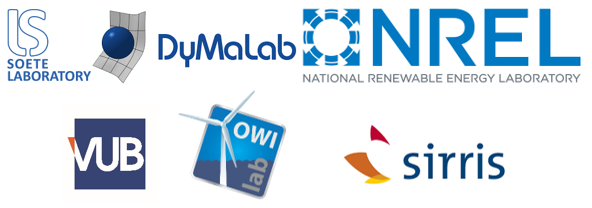Introduction
- MaSiWEC - Material and Signal processing based prediction of WEC probability
- Number of Partners: 5
- Coordinator: VUB
- Start Date 01/07/2018
- Duration: 4 Years
- Total Budget: €1.498.081
- Funded by SIM
MaSiWEC Consortium Partners

Project Context
The MaSiWEC project resides under the SIM program Material Durability for Off-Shore (MaDurOS), which was created in 2012. The driving force for initiation of this program was the reality that the off-shore environment puts severe durability requirements on materials, one particular characteristic being that material is often simultaneously faced with coupled damage mechanisms: corrosive, fatigue and/or abrasion. Within this program, MaSiWEC aims to tackle a phenomenon which plagues the wind industry, namely the degradation of drivetrain bearing material due to white etching cracking (WEC). WEC is known to be a coupled mechanism involving fatigue and environmental influences, and can reduce bearing lifetime to 30% or less of its expected value. Although the main drivers towards the occurrence of WEC have been identified, its exact mechanism of material degradation and the specific conditions leading to WEC are not yet understood. This hampers the development of predictive WEC lifetime models and improved monitoring strategies that can account for the likelihood and progression rate of WEC.
Project Description
MaSiWEC provides a unique collaboration between Flemish academic institutes and industrial value chain players, and NREL (National Renewable Energy Laboratory, USA). Three major project lines are put forward:
1. Advanced microstructural investigations on (failed) bearing materials will produce statistically reliable data to construct a sound hypothesis for the mechanism of WEC, and a quantitative model for effects of microstructural parameters on macrostructural material performance. This information will then be fed into the following two project lines.
2. A predictive model for bearing lifetime will be developed, based on the physics of WEC and with attention for pragmatism. This model will include the stages of crack initiation and propagation, and will result in a likelihood criterion for the development of WEC and a quantitative assessment of remaining lifetime.
3. A WEC assessment methodology will be set out on the level of the bearing system, based on load and vibration monitoring signals. Supported by the gained material knowledge, combinations of WEC initiators will be linked to the operational states of the turbine. A simplified load monitoring technique is proposed based on strain gauges installed in the wind turbine tower and a dynamic drivetrain model (in collaboration with NREL).
These three project lines are eventually joined and iteratively optimized into a synergetic framework for “Material Based Probability of Failure (MB-PoF)”. This framework will be validated and strengthened by an on-shore turbine measurement campaign executed by NREL and a measurement campaign in a Flemish off-shore wind-mill park.


